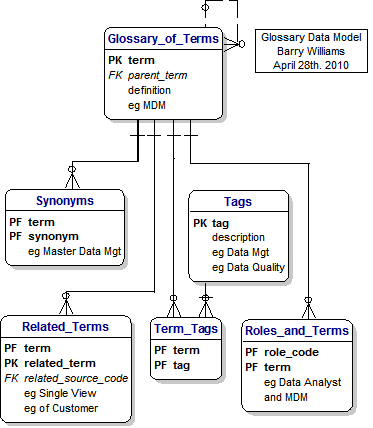
|
Since it was created about 8 years ago, this WebSite has grown to over 9,000 pages.
Even the creators find it difficult to remember all the content ;-)
Therefore we have decided to provide an additional front-end for the User based on a Glossary of Terms.
We hope to complete a Proof-of-Concept for this work by the end of May, and if you have comments or
you would like to be involved, please let us know
In the meantime, here's the Plan :-
- Step 1. Design the structure of the Glossary
This is shown in the diagram on the left.
- Design Principles
1. Why use a Glossary ?
- Because it provides a structured and flexible Approach
2. Which Data Format to use ?
- The choice is wide - including Word, Excel, a Database and XML
- We choose static HMTL for the POC, and then a Database and finally XML as the publishing medium
3. What is the appropriate level of Granularity ?
- Terms or Entries in the Glossary.
- Because we can move any Term up or down the hierarchy.
- Step 2. Establish the Rules for creating new Entries in the Glossary.
- Step 3. Design links from the Glossary Content and Tags to the
Pages in the WebSite.
- Step 4. Decide how the top-level Glossary will be presented to the User as the starting-point for an Enquiry.
This will be an alphabetic list of Entries in the Glossary and a Search facility.
- Step 5. Decide how the Search results will be presented to the User, for example a
Glossary Entry.
- Step 6. Produce Specifications for the Proof-of-Concept showing a Glossary-Driven User Scenario.
This will be based on the Top 50 Search terms used on the WebSite.
- Step 7. Build the Proof-of-Concept using a relational Database that supports XML.
- Step 8. Review the Approach based on User Feedback.
- Step 9. Develop the Pilot System.
Some useful Products :-
|


